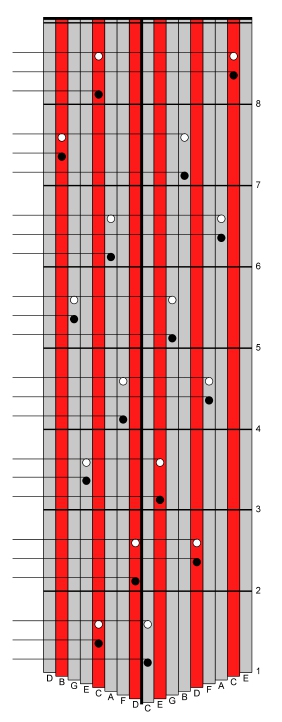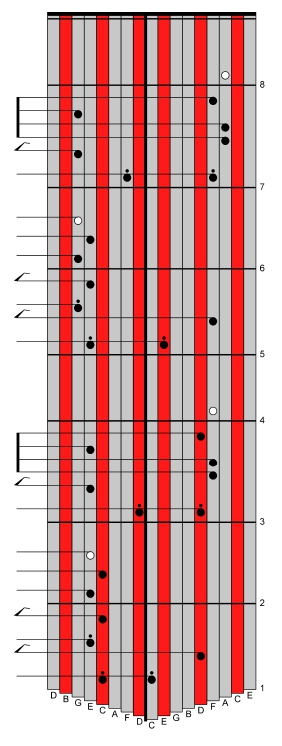Here is a great tip to help you play the 17-note kalimba. Actually, most “regular” kalimbas follow this rule, so read on even if you have an 8-Note, an Alto, a Treble, or a Pentatonic kalimba.
“Regular” kalimbas have low notes in the center, and as you go farther from the center, notes get higher. Consecutive notes alternate from right to left, going outward as you go up the scale.
Consider the scale “Do Re Mi Fa So La Ti Do” = “1 2 3 4 5 6 7 8.” If the low note, “Do” is on the right side, and the “Re” note is on the left side… you will find that the high “Do” is on the left side of the kalimba, on the hand opposite the lower version of the same note.
Check out what this means when you’re playing the kalimba!

In case you don’t know what an octave is, it is the distance between the low note and the high note of the scale: “Do Re Mi Fa So La Ti Do.” They both have the same name – “Do.”
You can find octave pairs on your kalimba by looking at different notes with the same name. For example, there are two F notes, two G notes… and three C notes.
When you find two or more tines that play different versions of the same notes… two E tines, for example – play those notes and listen to how they are related. They are the same note, harmonically, but one is a higher version and the other is a lower version.
It is really good to know about these octave pairs, because one note can be substituted for the other.
The tablature here shows a number of octave pairs on the 17-note kalimba in C. The first note is low C, followed by middle C, and ending with both C notes played simultaneously.
In each case, the two notes of the octave pair are on opposite sites of the kalimba. This makes it very easy to play the two notes at the same time.
In the song h ere, “Doe, a Deer,” the melody is played in the midrange of the kalimba, switching back and forth between the left and right thumbs, and a harmony note is played one octave lower than the initial melody note of each two measure phrase.
ere, “Doe, a Deer,” the melody is played in the midrange of the kalimba, switching back and forth between the left and right thumbs, and a harmony note is played one octave lower than the initial melody note of each two measure phrase.
For example, in measure 1, the melody note is the middle C on the left, and the harmony note is low C on the right.
This is a common mode for playing your kalimba – to play a melody, but to support the melody harmonically and rhythmically by starting each measure or each phrase with a chord.
Usually the chord is played by the thumb that doesn’t have the melody at that moment.
This makes for a common manner of adding chords to a melody – aim at one, two, or three tines on the side opposite the melody download note, and try to make that chord much lower than the melody note.
It is a very useful “Rule of Thumb” that you can use to spontaneously harmonize every melody you learn on the kalimba, and it is a great heuristic (enabling a person to discover or learn for themselves) compositional tool for creating new music.
Strangely, the main reason I am writing about octave pairs on the 17-Note kalimba is to contrast it to the new Duncan-tuned kalimba. The Duncan-tuned kalimba only has six unique notes per octave, as opposed to the typical seven unique notes (“Do Re Mi Fa So La Ti”) of the regular major scale. This means that the Duncan-tuned kalimba doesn’t change sides as you go up an octave. Rather, octave pairs live on the same side of the kalimba.
That means that the Duncan-tuned kalimba is played totally differently than your typical kalimba. And it also means that your Duncan-tuned kalimba can play totally different music as compared to a similar kalimba in the standard tuning. So, if you are looking for a very different way of playing kalimba, check out the Duncan-tuned kalimba. But if you don’t, do learn the octave pairs on your kalimba in its standard tuning.


Sign up for our newsletter and free resources with your email address:
We pinky promise not to spam you and to only send good stuff.
 Christmas in July 2025
Christmas in July 2025 Patriotic and American Music for Kalimba
Patriotic and American Music for Kalimba